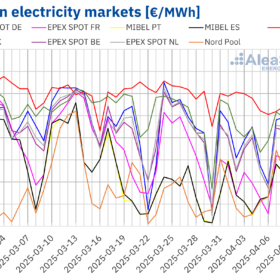Top News
Dutch utilities to test lower tariffs during solar production peaks

Average silver price up 21% in 2024, says Silver Institute

European electricity prices stabilize as gas, CO2 prices drop

China identifies major high-purity quartz deposits for PV industry

South Korea’s 2024 solar additions surpassed 3.1 GW
Fraunhofer ISE developing heterojunction solar cells with silver consumption of less than 2 mg per W
CATL unveils 587 Ah battery energy storage cell
US distributed solar grew 5.4 GW in 2024
Press Releases
WHES Opens Intelligent AI Center in Shanghai, Advancing Smart Energy Storage Solutions
Sineng Electric Unveils Next-Generation 430kW Liquid Cooling String PCS, Pioneering a New Era of High-Power Energy Storage Solutions
Astronergy wins 2 GW bidding from a state-owned giant
OMV Petrom and CE Oltenia move forward with four photovoltaic projects: execution contracts signed
Opinion & Analysis
Featured
Who are the solar and wind champions?
IEA’s World Energy Outlook systemically underestimates solar PV development
Since 1993, the World Energy Outlook (WEO) of the International Energy Agency (IEA) has been an authoritative report on energy statistics and guiding future energy supply and demand developments. An examination of these reports, however, indicates that even the most progressive of WEO scenarios has vastly underestimated the growth of renewable energy technologies, especially solar PV.
‘We need to empower younger professionals in decision-making processes’
This week, Women in Solar Europe (WiSEu) gives voice to Rachele De Angelis, European Affair Officer at Italy’s Enel. She says bringing fresh ideas from new academic backgrounds and early career experiences can help companies achieve transformative insights. “These perspectives can challenge old assumptions and generate more creative and inclusive solutions,” she states.
FOB China module prices rise amid growing market expectations of sharp correction by end-Q2
In a new weekly update for pv magazine, OPIS, a Dow Jones company, FOB China TOPCon below 450 W modules for spot loading were stable at $0.093/W, with price indications between $0.087-0.100/W. Furthermore, it reveals that current price increases are not being uniformly adopted across all Chinese manufacturers, with significant price differences—often several euro cents— being observed between the Top 5 and Top 10 manufacturers.
UK, Germany lead March solar surge amid Mediterranean cloud cover
In a new weekly update for pv magazine, Solcast, a DNV company, reports that irradiance across England, the Benelux region, Denmark, northern France, northern Germany, and northern Poland surged well above long-term March averages. In the UK, aggregated solar irradiance reached its highest March value since 2014.
The rise of bankable BESS projects in Europe
As the renewable energy sector rapidly evolves, battery energy storage systems (BESS) are emerging as a critical pillar for decarbonization. However, with capital constraints and rising market volatility, not all projects are equally viable. At ABO Energy, we’re witnessing a shift in the investment landscape, where preparedness is the key to success.
Markets & Policy
Featured
Fortescue begins working on 190 MW of solar in Australia
Global corporate solar funding falls 41% to $4.8 billion in Q1 2025
Corporate funding in solar fell considerably in the first three months of this year due to policy reversals, tariff shocks and regulatory uncertainties, says a report from Mercom Capital.
Emmvee expands solar module capacity to 6.6 GW
India’s Emmvee has inaugurated a new solar module plant in India, boosting its total PV module capacity to 6.6 GWp and solar cell capacity to 2.5 GWp. The expansion strengthens its position in the nation’s rapidly scaling solar manufacturing sector.
Texas Senate passes anti-solar, wind bill
The bill places permit restrictions, fees and new regulatory requirements for solar and wind projects.
The Hydrogen Stream: EU backs €400 million H2 scheme in Spain
The European Commission has cleared a €400 million ($455.2 million) Spanish aid program to scale renewable hydrogen output, backing up to 345 MW of electrolyzer capacity and targeting 221,000 tons of production via the EU Hydrogen Bank’s 2025 auction round.
Romania’s energy authority proposes new grid connection rules
Romania’s energy regulator has proposed new grid connection rules to extend connection agreement terms and set a firm deadline for paying the 5% financial guarantee required to secure a permit, with public consultation open through April 21.
Installations
Featured
Fire risks in industrial rooftop solar systems due to poor installation
Eskom seeking partners to set up independent renewables unit
Eskom has issued a tender for partners to help launch a standalone renewables division, in a bid to speed up clean energy development in South Africa. The utility says it will evaluate bids based on sector experience, financial expertise, and project delivery record.
Fronius launches hybrid inverters for residential, commercial applications
The Austrian manufacturer said its new hybrid inverters can increase the usable output of the PV system to up to 150%. They are available in six version with rated AC power ranging from 15 kW to 33.3 kW.
Sungrow releases modular inverter for utility-scale solar
The Chinese manufacturer said its new product uses inverter units with an output of 800 kW, of which 12 can be connected in parallel. It can work in weather of up to 52 C.
European renewables PPA market hit 19 GW in 2024, says Wood Mackenzie
Wood Mackenzie says Europe’s power purchase agreement (PPA) market was dominated by solar and wind deals in 2024, with an increase in battery-linked contracts as buyers looked to hedge against negative pricing periods.
Belgian grid operator warns of PV overproduction, curtailment in spring
Belgian grid operator Elia says that rapid solar fleet growth is driving earlier seasonal overproduction peaks, raising curtailment risks this spring. It plans to expand flexibility measures to stabilize the high-voltage network.
Technology
Featured
Hithium debuts 587 Ah cell and 6.25MWh storage system
Thornova offers solar module composite frames
Chinese manufacturer Thornova says that its new composite frames offers advantages in terms of stability, corrosion, and chemical resistance. Installation is also easier because no grounding is required.
UK grid connections reform approved to ‘axe zombie projects’, fast-track 65 GW solar deployment
UK energy regulator Ofgem has approved connection queue reforms for Great Britain’s electricity grid. The change could see 65 GW of solar projects enter the fast-track “Gate 2” connections queue. The government claims reform will accelerate renewables and energy storage deployment while unlocking GBP 40 billion ($53 billion) of investment in clean energy and infrastructure.
CEA-INES unveils PV module interconnection tech that reduces silver use by 26%
The French research institute found that switching from silver cell metallization to silver-copper metallization can lower the total silver quantity in a heterojunction module, with a total silver amount of only 14 mgAg/W being required. Their interconnection technique is based on low silver content electrically conductive adhesives and copper ribbons.
U.S. researchers developing photovoltaic dual-axis canopy
The “morphing skin” would track sunlight and have the flexibility and surface area to wrap across large surfaces, such as buildings and stadiums.
Japan’s NEDO opens fiscal 2025 funding round for solar tech innovation
Japan’s national energy R&D agency has launched a five-year R&D program to accelerate solar innovation. The fiscal 2025 call for proposals seeks advances in high-efficiency cells, site-specific systems, PV module recycling, and long-term power stability.
Manufacturing
Featured
Solar cells not exempt from US tariffs despite media reports
Chinese PV Industry Brief: PowerChina cancels 51 GW module tender for 2025
PowerChina has scrapped its 51 GW solar module tender for 2025 due to the impact of policy shifts on procurement needs. The tender, which began in November 2024, attracted 58 bids, with average quotes of CNY 0.68 ($0.093)/W for tunnel oxide passivated contact (TOPCon) modules and CNY 0.773/W for heterojunction (HJT) modules.
Global solar module shipments hit 703 GW in 2024
The new edition of the International Technology Roadmap for Photovoltaic (ITRPV), published this week, reports that average PV module prices last year dropped by 33% compared to the end of 2023.
EcoFlow launches balcony PV system, batteries with AI features
EcoFlow’s new Stream series, its second-gen balcony solar plant, enables battery coordination and plug-and-play solar for distributed batteries, plus third-party microinverter coordination for its new battery.
New research sheds light on intrinsic limitations of selenium solar cells
Danish researchers have analyzed fundamental material properties of selenium solar cells and have found their potential is higher than generally believed. They used carrier-resolved photo-Hall analysis to address discrepancies and reproduce experimental current-voltage and external quantum efficiency measurements.
Longi claims world’s highest efficiency for silicon solar cells
Longi said it has achieved a 27.81% efficiency rating for a hybrid interdigitated back contact, as confirmed by Germany’s Institute for Solar Energy Research Hamelin (ISFH).
Energy Storage
Featured
Vietnam publishes feed-in tariffs for large-scale solar-plus-storage
TrinaStorage launches Elementa 3 utility-scale battery storage system
The new utility-scale battery energy storage features 565 Ah cells and delivers a rated capacity of 6.017 MWh with a typical discharge duration of four hours.
Key takeaways from SolarEx Istanbul
The 17th edition of SolarEx Istanbul, which took place from April 10 to April 12, was the largest to date. As Turkey’s solar deployment increases, there was discussion on how to manage future installations, develop untapped domestic markets, and secure future investments.
Frascold, Tecnofreddo present high-temperature propane heat pump
Conceived for industrial applications, the Danae heat pump system is available in 10 versions with cooling capacities ranging from 22.1 kW to 156.9 kW and heating capacities spanning from 24.8 kW and 181.6 kW.
Australian entities say V2G tech ready for market
Essential Energy, the Commonwealth Scientific and Industrial Research Organisation (CSIRO), renewable tech company Sigenergy and electric vehicle distributor AUSEV have jointly announced vehicle-to-grid (V2G) technology is market ready in Australia.
Sungrow launches fully integrated C&I battery
With a fully integrated power conversion system (PCS), battery management system (BMS), and energy management system (EMS), PowerStack 255CS aims to streamline energy storage operations while reducing installation complexity.














